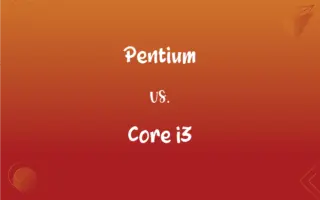Nematic Liquid Crystals vs. Smectic Liquid Crystals: What's the Difference?
Edited by Aimie Carlson || By Janet White || Published on February 21, 2024
Nematic liquid crystals have molecules oriented randomly in layers, offering flexibility; smectic crystals have organized, tightly packed layers, providing more structure.

Key Differences
Nematic liquid crystals are characterized by their molecules being aligned in parallel but without any positional order. This results in a fluid-like behavior with good optical properties. Smectic liquid crystals, however, have molecules arranged in well-defined layers with both positional and orientational order, leading to a more structured and less fluid nature.
The flexibility of nematic liquid crystals is higher due to the lack of strict molecular arrangement, making them ideal for applications like LCD screens where variable optical properties are required. Smectic liquid crystals, with their rigid layer structure, exhibit different optical properties, often resulting in a stronger response to changes in temperature or electric fields.
Nematic liquid crystals are easier to align under an electric field, which is why they're commonly used in display technologies. In contrast, the smectic phase, due to its layered structure, can display a variety of textures and patterns but is less responsive to external fields compared to the nematic phase.
The temperature range for the nematic phase is typically broader, making these crystals more stable under varying temperatures. Smectic liquid crystals have a narrower temperature range for their distinct phase and can transition into other phases more easily with temperature changes.
In terms of applications, nematic liquid crystals are widely used due to their easy alignment and clear display properties. Smectic liquid crystals, while less common, have unique applications in areas that require stable, layered structures, like certain optical devices and sensors.
ADVERTISEMENT
Comparison Chart
Molecular Alignment
Parallel, but random positioning
Organized in layers with strict order
Flexibility
Higher flexibility
Less flexible, more structured
Response to Electric Fields
Easily aligned under electric fields
Less responsive to electric fields
Temperature Stability
Broader stable temperature range
Narrower temperature stability range
Common Applications
LCD screens, displays
Specialized optical devices, sensors
ADVERTISEMENT
Nematic Liquid Crystals and Smectic Liquid Crystals Definitions
Nematic Liquid Crystals
Liquid crystals with high flexibility in molecular arrangement.
The flexibility of nematic liquid crystals makes them ideal for electronic screens.
Smectic Liquid Crystals
Layered molecular arrangement in liquid crystals.
The layered structure of smectic liquid crystals gives them unique thermal properties.
Nematic Liquid Crystals
Phase characterized by parallel alignment without positional order.
In nematic liquid crystals, molecules flow freely while maintaining alignment.
Smectic Liquid Crystals
Structured phase with molecules in organized layers.
Smectic liquid crystals form distinct layers, creating a unique visual effect.
Nematic Liquid Crystals
Aligned molecules in a non-fixed pattern.
Their random positioning allows nematic liquid crystals to adapt quickly to changes.
Smectic Liquid Crystals
Liquid crystals with molecules in a fixed, orderly pattern.
In smectic liquid crystals, each layer behaves like a distinct film.
Nematic Liquid Crystals
Liquid crystalline phase with disordered molecular positions.
Nematic liquid crystals exhibit distinct optical properties due to their molecular alignment.
Smectic Liquid Crystals
Phase with positional and orientational molecular order.
Smectic liquid crystals' organized structure affects their reaction to external stimuli.
Nematic Liquid Crystals
Fluid phase with molecules parallel but not ordered.
Nematic liquid crystals in the display change orientation when electrically stimulated.
Smectic Liquid Crystals
Liquid crystalline phase with tightly packed layers.
The tightly packed layers in smectic liquid crystals make them less fluid than other phases.
FAQs
Are smectic liquid crystals used in everyday devices?
Smectic liquid crystals are less common in everyday devices but are used in specialized optical devices and sensors.
What are nematic liquid crystals?
Nematic liquid crystals are a state of liquid crystal where molecules are aligned parallel without positional order.
Can smectic liquid crystals change phases easily?
Yes, smectic liquid crystals can transition into other phases more easily with temperature changes.
What makes nematic liquid crystals flexible?
The lack of strict molecular arrangement in nematic liquid crystals grants them higher flexibility.
What is the main use of nematic liquid crystals?
Nematic liquid crystals are primarily used in display technologies like LCD screens due to their optical properties.
Do smectic liquid crystals have a strong response to electric fields?
Smectic liquid crystals are less responsive to electric fields compared to nematic liquid crystals.
Can nematic liquid crystals be easily aligned?
Yes, nematic liquid crystals can be easily aligned under an electric field, making them suitable for displays.
Are smectic liquid crystals used in LCD screens?
Smectic liquid crystals are less commonly used in LCD screens compared to nematic liquid crystals.
What textures can smectic liquid crystals display?
Smectic liquid crystals can display a variety of textures and patterns due to their layered molecular arrangement.
How are smectic liquid crystals structured?
Smectic liquid crystals have molecules organized in well-defined layers, providing a structured arrangement.
How do nematic liquid crystals respond to temperature changes?
Nematic liquid crystals have a broad temperature range, remaining stable under various temperatures.
Is the molecular arrangement in nematic liquid crystals completely random?
While the molecules in nematic liquid crystals are parallel, their positions are random, providing fluidity.
Can smectic liquid crystals be used in high-temperature environments?
Smectic liquid crystals have a narrower temperature range, making them less suited for high-temperature environments compared to nematic liquid crystals.
What makes nematic liquid crystals ideal for electronic screens?
Their easy alignment, flexibility, and clear display properties make nematic liquid crystals ideal for electronic screens.
Can nematic liquid crystals be used in flexible displays?
Yes, the flexibility of nematic liquid crystals makes them suitable for flexible display technologies.
Are nematic liquid crystals stable under electrical influence?
Yes, nematic liquid crystals are stable and responsive under electrical influence, making them suitable for electronic displays.
How do the layers in smectic liquid crystals affect their properties?
The layers in smectic liquid crystals result in more structured properties, affecting their flexibility and response to stimuli.
What are the challenges in working with smectic liquid crystals?
The challenges include managing their less fluid nature and precise control due to their structured layers.
What is the optical property of nematic liquid crystals?
Nematic liquid crystals exhibit good optical properties with variable transparency and color modulation.
How do smectic liquid crystals react to external stimuli?
Smectic liquid crystals react to external stimuli like temperature and electric fields, but their response is influenced by their rigid, layered structure.
About Author
Written by
Janet WhiteJanet White has been an esteemed writer and blogger for Difference Wiki. Holding a Master's degree in Science and Medical Journalism from the prestigious Boston University, she has consistently demonstrated her expertise and passion for her field. When she's not immersed in her work, Janet relishes her time exercising, delving into a good book, and cherishing moments with friends and family.
Edited by
Aimie CarlsonAimie Carlson, holding a master's degree in English literature, is a fervent English language enthusiast. She lends her writing talents to Difference Wiki, a prominent website that specializes in comparisons, offering readers insightful analyses that both captivate and inform.







































































